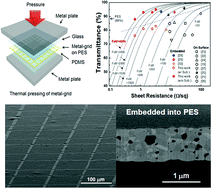Thermal pressing of a metal-grid transparent electrode into a plastic substrate for flexible electronic devices†
Abstract
A flexible transparent electrode (TE) is fabricated by thermal pressing of a metal-grid into a plastic film. The metal-grid is prepared by electrohydrodynamic continuous jet printing, which easily provides a high aspect ratio for the printed lines. Embedding the high-aspect-ratio metal-grid results in a smooth surface morphology that promotes the uniform deposition of functional materials over the metal-grid TE. The thermal-pressed metal-grid TEs show excellent electrical and optical performance: a sheet resistance of 0.5 Ω sq−1 and an optical transmittance above 80% lead to a figure of merit of 2000. The flexibility of the thermal-pressed metal-grid TE is investigated under both compressive and tensile bending stresses. Invariant electrical performance is observed for a bending radius of up to 3 mm. Less than 30% degradation of the original electrical performance occurs after 1000 compressive–bending cycles with a radius of 10 mm. Organic solar cells fabricated on the thermal-pressed metal-grid TEs demonstrate acceptable device performance equivalent to devices fabricated on commercial indium tin oxide glass. These properties confirm the feasibility of thermal-pressed metal-grid TEs for use in flexible electronics.


 Please wait while we load your content...
Please wait while we load your content...